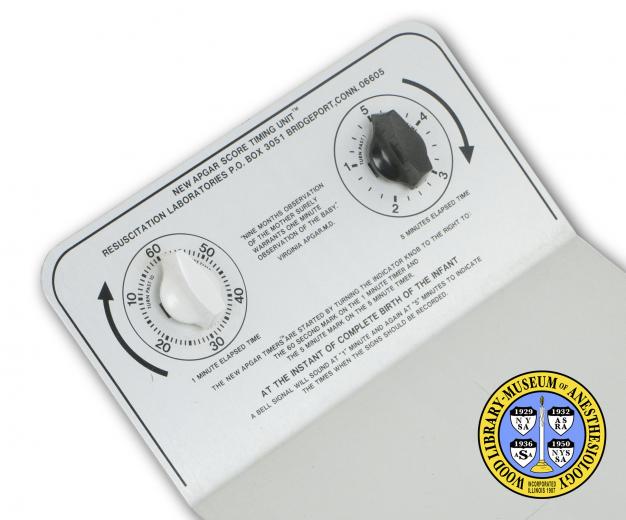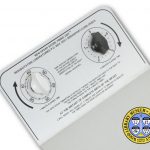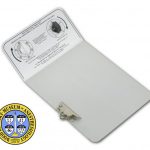Apgar Clipboard
Dr. Virginia Apgar (1909-1974) was an anesthesiologist and pioneer in perinatal medicine. Introduced in 1953, the Apgar score is a method of evaluating newborn infants based on five observable signs: heart rate, respiratory rate, muscle tone, reflexes and color. A number of 0, 1, or 2 is given to each sign and the score is totaled at one minute and again at five minutes after birth. Apgar’s method provided a meaningful standard that was used to study and compare various obstetric, anesthesia, and resuscitation practices, and led to improvements in the care of women during labor as well as newborn infants. The Apgar score continues to be used throughout the world to assess the health of newborns. Dr. Miguel A. Colon-Morales described the first version of his score timing clipboard in 1971. The New Apgar Score Timing Unit was designed to facilitate accurate and timely score-taking in a very busy and sometimes distracting environment.
Catalog Record: Apgar Clipboard
Access Key: aikh
Accession No.: 1992-05-13-1 A
Title: New Apgar score timing unit / [designed by Miguel A. Colon-Morales.]
Author: Colon-Morales, Miguel A.
Title variation: Alt Title
Title: Apgar clipboard.
Title variation: Alt Title
Title: Apgar score timer.
Title variation: Alt Title
Title: New Apgar score timing clip board.
Publisher: Bridgeport, Conn. : Resuscitation Laboratories, [197-].
Physical Descripttin: 1 clipboard : aluminum, plastic ; 43 x 24 x .15 cm.
Subject: Apgar Score.
Subject: Physical Examination.
Subject: Anesthesia, Obstetrical.
Subject: Infant, Newborn.
Subject: Apgar, Virginia, 1909-1974.
Note Type: General
Notes: Title from manufacturers markings on unit. Alternate title, “Apgar clipboard,
” is a common name for the object. “Apgar score timer,” is from an article
written by the designer, Dr. Colon-Morales. “New Apgar score timing clip
board” is the WLM name for the object.
Note Type: Citation
Notes: Apgar V. A proposal for a new method of evaluation of the newborn infant.
Curr Res Anesth Analg. 1953;32(4):260-267.
Note Type: Citation
Notes: Colon-Morales MA. Apgar-score timer. Anesth Analg. 1971;50(2):227-228.
Note Type: Physical Description
Notes: An aluminum clipboard with timers and clip; The aluminum plate that comprises
the base of the clipboard is approximately 1.5 mm thick; The upper portion of
the clipboard is bent approximately 30 degrees so that the uppermost 13 cm
faces toward the user when the clipboard is laid flat; Protruding from the
upper 13 cm portion of the clipboard are the timers’ dials; A white colored,
plastic dial timer for seconds is on the left, and a black dial timer for
minutes is on the right; The bodies of the timers protrudes from the back of
the clipboard, directly behind the dials; All of the manufacturer’s markings
are on the 13 cm upper-portion of the clipboard, above, between and below the
dials, and includes: “NEW APGAR SCORE TIMING UNIT [superscript] TM [new line]
RESUSCITATION LABORATORIES P.O. BOX 3051 BRIDGEPORT, CONN. 06605”; Between
the two dials is a quote: “‘NINE MONTHS OBSERVATION OF THE MOTHER SURELY
WARRANTS ONE MINUTE OBSERVATION OF THE BABY.’ VIRGINIA APGAR M.D.”;
Instructions for using the timers are printed below the dials; A clip (for
holding forms) is attached to the clipboard, centered on the far left side of
the flat portion of the clipboard.
Note Type: Reproduction
Notes: Photographed by Mr. William Lyle, 7/27/2010.
Note Type: Acquisition
Notes: Donated to the WLM by Miguel Colon-Morales, M.D., in 1992.
Note Type: Historical
Notes: Dr. Virginia Apgar (1909-1974) was an anesthesiologist and pioneer in
perinatal medicine. Introduced in 1953 in the journal Anesthesia and
Analgesia, the Apgar score is a method of evaluating newborn infants based on
five observable signs: hear rate, respiratory rate, muscle tone, reflexes and
color. A number of 0, 1, or 2 is given to each sign and the score is totaled
at 1 and 5 minutes after the infant is born. Prior to the use of the Apgar
score documentation of the newborn assessment was subjective and lacked
consistency. Apgar’s method provided a meaningful standard that was used to
study and compare various obstetric, anesthetic, and resuscitation practices,
which in turn led to improvements in the care of newborn infants and their
mother’s during labor. The Apgar score is still used to assess newborn
infants throughout the world. From 1959-1974 Dr. Apgar worked for the March
of Dimes, leading in perinatal research, public health, and public education.
Note Type: Historical
Notes: The designer of this clipboard, Dr. Miguel A. Colon-Morales described the
first version of his Apgar clipboard timer in 1971 in the journal Anesthesia
& Analgesia. It includes timers for the 1 minute and 5 minute marks, and a
clip to hold a scoring form. Dr. Colon-Morales designed the board to
facilitate accurate and timely score taking in a very busy and sometimes
distracting environment. He called it the “Apgar Score Timing Unit.” The
first version of the clip-board had one timer at the top in the center.



